Jerusalem stone may answer Jewish revolt questions
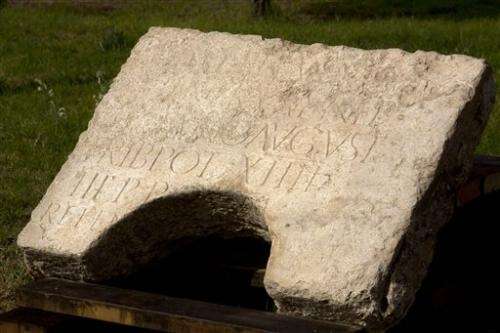
Israeli archaeologists said Tuesday they have discovered a large stone with Latin engravings that lends credence to the theory that the reason Jews revolted against Roman rule nearly 2,000 ago was because of their harsh treatment.
Israel's Antiquities Authority said the stone bears the name of the Roman emperor Hadrian and the year of his visit to Jerusalem, a few years before the failed Bar Kochba revolt in the second century A.D. The inscription backs up historical accounts that Rome's Tenth Legion was present in Jerusalem in the run-up to the revolt.
The cause of the Jewish revolt, which resulted in their exile, is disputed. It is unclear whether they rose up independently or were provoked by harsh Roman measures, but the presence of the legion would give credence to the latter.
Hadrian is reviled in Jewish history for imposing dictates aimed at persecuting Jews and forcing them to abandon their religion.
Along with Jewish accounts, the history of the Bar Kochba revolt is also known from the works of Roman historian Cassius Dio, who mentions that Hadrian visited Jerusalem in 129 A.D., three years before the revolt erupted.
The stone was found outside Jerusalem's Old City.
-
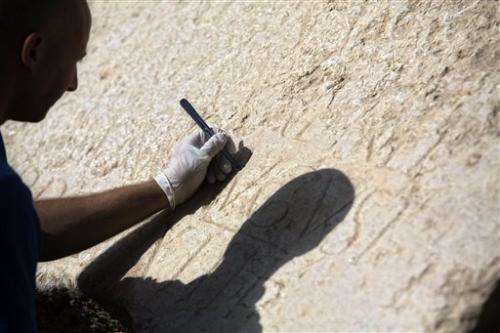
Shmulik Freireich, an Israel Antiquities Authority conservationist works on a commemorative inscription dedicated to the Emperor Hadrian that was found outside Jerusalem's Old City, at the Rockefeller museum in Jerusalem. Tuesday, Oct. 21, 2014. Israeli archaeologists said Tuesday they discovered a large stone with Latin engravings that lends credence to the theory that the reason Jews revolted against Roman rule nearly 2,000 ago was because of their harsh treatment. Israel's Antiquities Authority said the stone bears the name of the Roman emperor Hadrian and the year of his visit to Jerusalem, a few years before the failed Bar Kochba revolt in the second century A.D. (AP Photo/Sebastian Scheiner) -
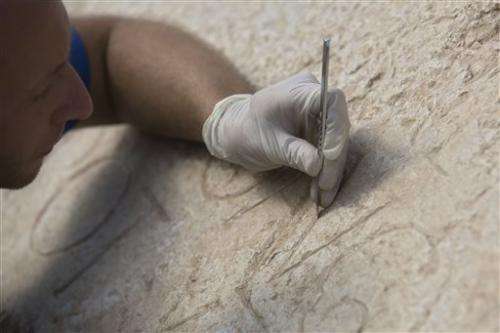
Shmulik Freireich, an Israel Antiquities Authority conservationist works on a commemorative inscription in stone dedicated to the Emperor Hadrian that was found outside Jerusalem's Old City, at the Rockefeller museum in Jerusalem. Tuesday, Oct. 21, 2014. Israeli archaeologists said Tuesday they discovered a large stone with Latin engravings that lends credence to the theory that the reason Jews revolted against Roman rule nearly 2,000 ago was because of their harsh treatment. Israel's Antiquities Authority said the stone bears the name of the Roman emperor Hadrian and the year of his visit to Jerusalem, a few years before the failed Bar Kochba revolt in the second century A.D. (AP Photo/Sebastian Scheiner) -
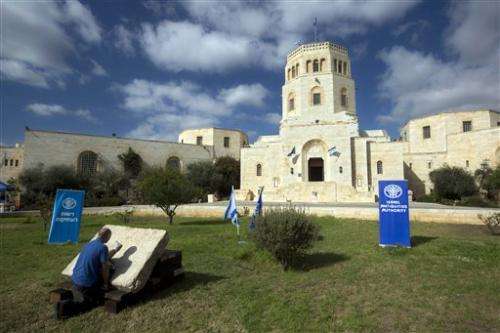
Shmulik Freireich, an Israel Antiquities Authority conservationist works on a commemorative inscription in stone dedicated to the Emperor Hadrian that was found outside Jerusalem's Old City, at the Rockefeller museum in Jerusalem, Tuesday, Oct. 21, 2014. Israeli archaeologists said Tuesday they discovered a large stone with Latin engravings that lends credence to the theory that the reason Jews revolted against Roman rule nearly 2,000 ago was because of their harsh treatment. Israel's Antiquities Authority said the stone bears the name of the Roman emperor Hadrian and the year of his visit to Jerusalem, a few years before the failed Bar Kochba revolt in the second century A.D. (AP Photo/Sebastian Scheiner) -
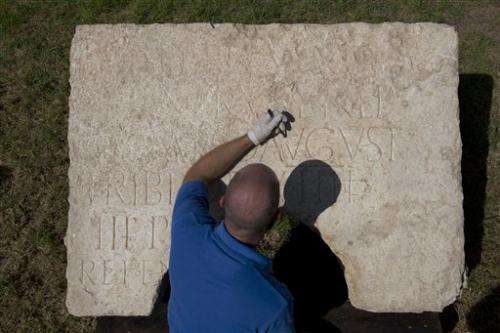
Shmulik Freireich, an Israel Antiquities Authority conservationist works on a commemorative inscription in stone dedicated to the Emperor Hadrian that was found outside Jerusalem's Old City, at the Rockefeller museum in Jerusalem. Tuesday, Oct. 21, 2014. Israeli archaeologists said Tuesday they have discovered a large stone with Latin engravings that lends credence to the theory that the reason Jews revolted against Roman rule nearly 2,000 ago was because of their harsh treatment. Israel's Antiquities Authority said the stone bears the name of the Roman emperor Hadrian and the year of his visit to Jerusalem, a few years before the failed Bar Kochba revolt in the second century A.D. (AP Photo/Sebastian Scheiner)
© 2014 The Associated Press. All rights reserved.




















